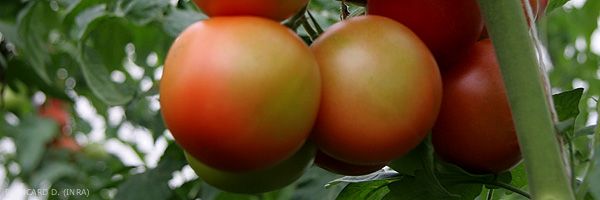
Physiological marbling of fruits
( blotchy ripening )
( blotchy ripening )
- Symptoms on fruits
Green to yellow areas of varying extent, appearing on ripe fruits (Figures 1 to 3), of firm consistency and making them unsuitable for marketing. In other words, partial ripening of the fruit in spots ( blotchy ripening ) occurring rather in the stalk zone. A transverse cut in the fruits makes it possible to confirm their partial ripening, as well as the browning of certain vessels of the pericarp in the still green areas ( internal browning ).
Marbling is most evident in early, unheated or late fall greenhouse crops. It is reported worldwide and sometimes seems to be described under other names. Remember that comparable symptoms are associated with attacks ToMV .- Origin of damage
Rather poorly understood non-parasitic disease
Several factors seem to favorably influence this condition:
- excess nitrogen and calcium, a lack of potassium;
- periods of reduced light, alternating cloudy and sunny periods;
- too low electrical conductivity of the soil or the nutrient solution, associated with excess water and too low temperatures;
- heavy soils.
There are big differences in sensitivity between varieties.
- How to cure it
It is enough to manage as well as possible the parameters influencing its expression.
The plant and its behavior
- Cultivate varieties that are not very sensitive, the old cultivars being rather more sensitive.
- Avoid overly vegetative plants.
- Remove leaves to improve the exposure of the bouquets to light.
The climate
Avoid maintaining too low temperature setpoints, especially at night.
Ferti-irrigation
- Control watering and maintain high electrical conductivities.
- Limit nitrogen inputs and increase potassium fertilization.





